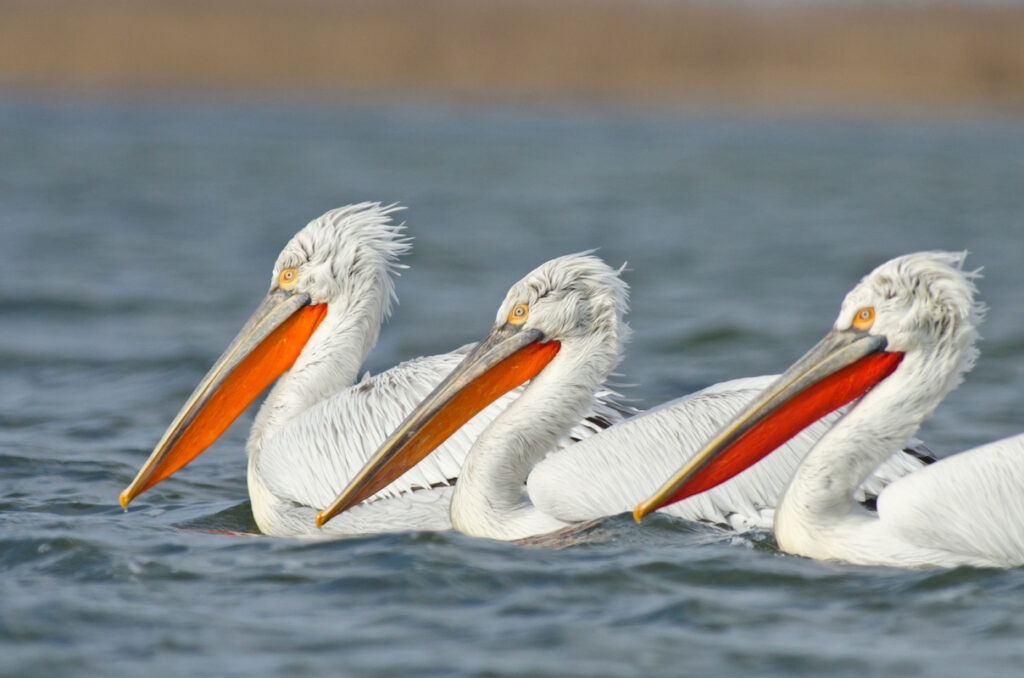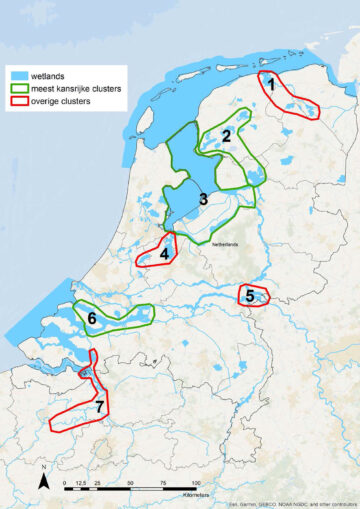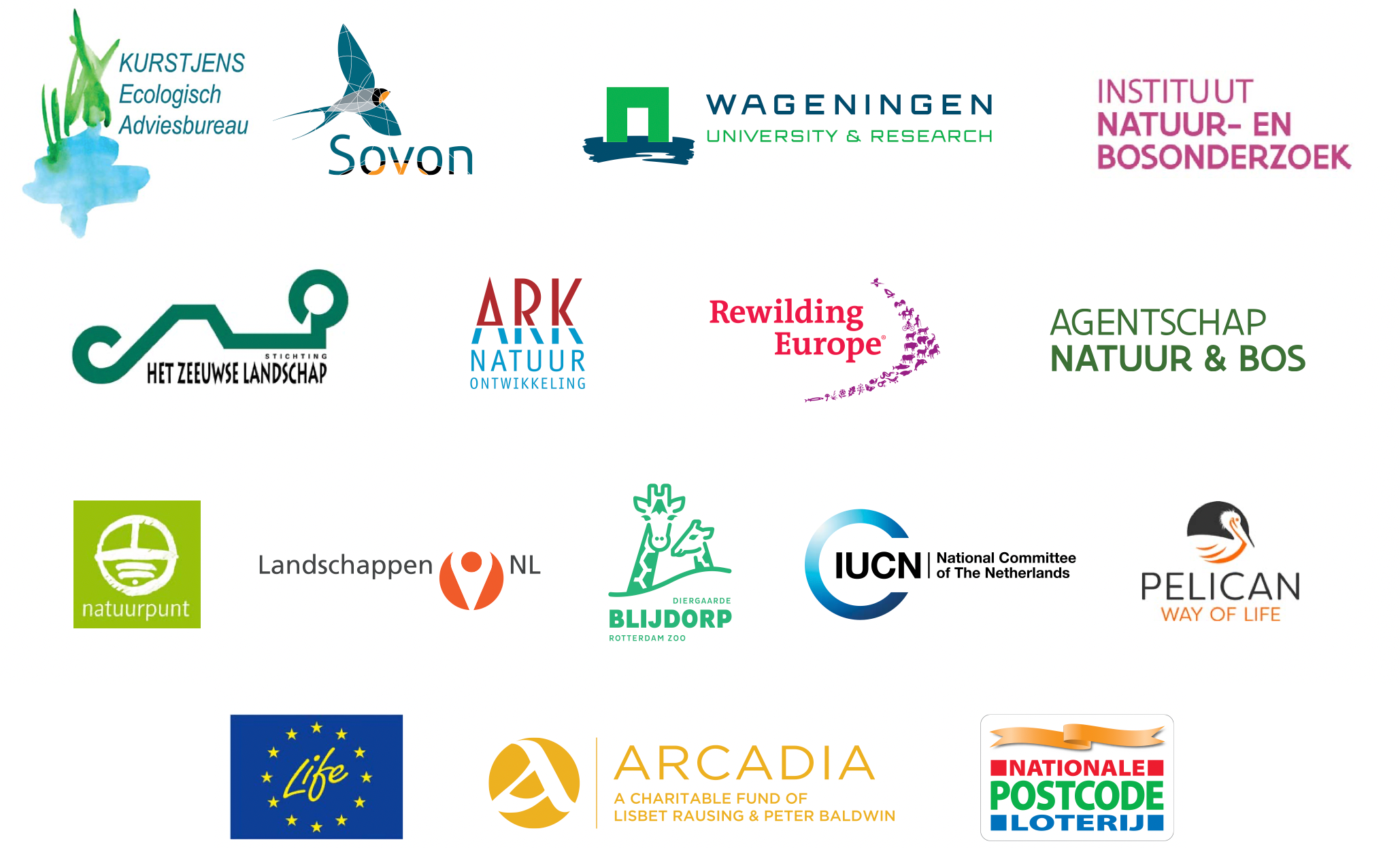A new study has identified suitable habitat in the Netherlands and Flanders that could support at least 250 breeding pairs of Dalmatian pelicans once again. The findings highlight the growing potential for a reintroduction after an absence of over 500 years.

Restoring what was lost
Once a common sight in the Low Countries until the 15th century, inhabiting estuaries along the coast, their numbers dwindled due to overhunting and habitat loss. Now much of that habitat has been restored and hunting is far less of a threat. The Netherlands could now provide suitable breeding conditions for the Dalmatian pelican (Pelecanus crispus).
A new study entitled “Opportunities for Dalmatian Pelican in the Netherlands and Flanders” assesses the ecological situation and the feasibility of their return, offering hope for future rewilding initiatives with the Dalmatian pelican acting as a highly visible and charismatic ambassador species for wetland restoration.
Based on archaeological bone remains and historical accounts, the Dalmatian pelican is known to have inhabited the Netherlands, most probably as a breeding bird. Nowadays it is generally accepted that the Dalmatian pelican is a former native species. With a number of suitable breeding sites identified in the new report, these magnificent birds could once again grace the Dutch and Flemish skies in substantial numbers.
Ecological and biological needs
With a range spanning across much of Eurasia, from the Mediterranean in the West to the Taiwan Strait in the East, the Dalmatian pelican can be found in lakes, rivers, deltas and estuaries. In Europe, the species is restricted to the south-eastern part of the continent due to its preference for relatively warm temperatures.
Compared to the great white pelican, the Dalmatian is less opportunistic in breeding habitat selection, usually returning to a traditional breeding site year after year unless it becomes completely unsuitable. The species needs predator-free islands, without dense vegetation and trees, and adapts well to artificial nesting platforms in areas without disturbance.
Despite being strictly piscivorous birds, conflicts with fishing interests are unlikely, due to the fact Dalmatian pelicans mostly eat small freshwater fish that are of no interest to fishermen in the Netherlands or in other countries from its current range.
Promising results

The study “Opportunities for Dalmatian Pelican in the Netherlands and Flanders” was conducted by Kurstjens Ecological Consultancy, Sovon Vogelonderzoek Nederland, Wageningen University & Research and the Flemish Institute for Nature and Forest Research. The data presented in the study was drafted after a close collaboration with various Rewilding Europe specialists who are involved in the ongoing European LIFE project ‘Pelican Way of LIFE‘. The study was commissioned by a consortium of nine Dutch, Flemish and European nature organizations: ARK Natuurontwikkeling, Stichting Het Zeeuwse Landschap, Rewilding Europe, Agency for Nature and Forests, Natuurpunt, LandschappenNL, Diergaarde Blijdorp, IUCN NL and Pelican Way of Life.
This report shows that there is now again sufficient suitable habitat for an independent population in the Netherlands and Flanders. The most suitable areas for this species are the Flevoland and IJssel estuaries, the Frisian and Overijssel lake areas and the lower river areas of Biesbosch, Haringvliet and Krammer-Volkerak. The sites have been selected on the basis of two main criteria:
1) the food availability (based on fish densities and cormorant colonies in the proximity of waters deeper than 1.5 m).
2) a minimum area of protected nature reserves (>1.500 ha) to guarantee sufficient rest.
The selected sites were then clustered into broad landscape units that reflect the scale in which the species uses the landscape. Additional criteria were analysed, such as availability of islands as nesting sites, limitations due to the presence of high-voltage power lines and wind farms, and recreational pressure.
As a result, a top three of promising clusters emerged, which could sustain a population of at least 250 breeding pairs of the Dalmatian pelican. The conclusion was formulated with caution and assumptions, as the need for further study is essential at this stage.

Future strategies easing its return
Spontaneous return of the Dalmatian pelican as a breeding bird is not realistic in the medium-term, due to their current strongholds being a great distance away in south-eastern Europe. Since it is unlikely the species will return on its own, a reintroduction should be considered.
For this, a follow-up study is needed to definitively pinpoint the best location and approach, and what measures need to be taken to ensure a viable population can become established in the long-term without conflicts arising.
This includes optimizing breeding islands and making high-voltage wires and wind turbines more visible, because Dalmatian pelicans are particularly sensitive to collisions with energy infrastructure during take-off and landing. For the Netherlands and Flanders, the placement of new wind farms near wetlands in particular deserves attention in relation to foraging flights of pelicans. However, effective mitigation measures are available (including bird-diverting features on pylons and a ‘standstill facility’ of wind turbines). According to the authors, the Dalmatian pelicans will probably be able to profit from measures that have already been taken for protected birds present in and around N2000 areas, such as the white-tailed eagle and common crane.
In addition to these measures, a future return of the Dalmatian pelican would be eased through the restoration and expansion of wet nature areas that has been realized in the Netherlands in recent decades. As a flagship species for wetland habitat and an important indicator for improved water quality and fish abundance, its presence will not only galvanise existing rewilding efforts, but help to inspire further wetland rewilding.
Want to know more?
- Read the study “Opportunities for Dalmatian Pelican in the Netherlands and Flanders”
- LIFE programme “Pelican way of life”

